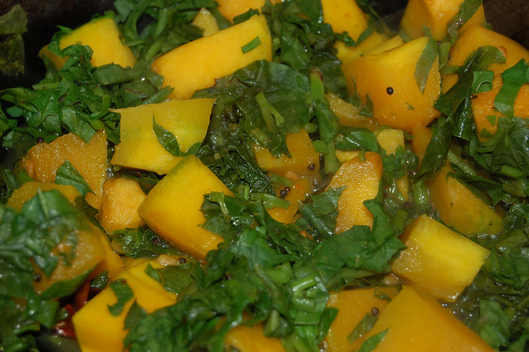Vegetables
And Spices – The Pillars Of Indian Cuisine

The migration of Indians – and the increasing
influence it entails – has made Indian food one of the most popular in the
world. In Great Britain, where large populations of Indians are located, a
recent survey revealed that a good number of Britons loves eating curry and
vindaloo.
All the spices and foreign-sounding ingredients make Indian cuisine seem intimidating, but in reality, it is quite simple. A good first step is to procure the basics that give Indian cuisine its distinctive taste: turmeric, curry, ginger, cardamom, red chili powder, coriander, carom seeds, cloves and nutmeg. If you think this list is too extensive for you to make sense of it all, you can do a shortcut and just purchase some garam masala. This amalgamation of everything Indian takes the guesswork and sets you on the right track.
A trick Indian cooks use is toasting spices before they use them. This process intensifies the taste of already potent spices and takes the experience to a whole new level. If you want to try it out, a cast iron skillet is best used. Over medium heat, place the spice you want to toast on the skillet and mix constantly for 2 minutes. Keep everything moving so that you don’t end up with a burnt mess. Be aware that the smell can be quite strong and can easily overwhelm someone who is not used to it. Warn your neighbors if necessary!
Quite a large number of Indian dishes are centered around vegetables. Garlic, black raisins, and tomatoes figure in the most common dishes. potatoes, eggplant, spinach, cauliflower, peas and beans all experience heavy use in Indian cooking and are featured prominently in both entrees and side dishes. If you see a pattern here, you are right, most Indian dishes are vegetarian. The dishes that do contain meat have very small quantities. If the dish contains beef, you can be sure that it is an Indian Muslim dish as Indian Hindus consider cows sacred and would never eat beef.
Vegetables are often fried or sautéed before being mixed in. Plain yogurt is popular as a marinade and as a coating for dishes headed for the tandoori oven. This creamy coating gives rise to a unique taste and helps balance the heat from the spices.
The Indian dining experience would not be complete if there is no serving of curry. Although ubiquitous, there is actually no single recipe that is uniformly followed. There are as many recipes of curry as there are Indian cooks, and you have to literally create your own through experimentation.
You can use crockpots if you will be cooking for a large banquet, it is a good idea to prepare the dishes ahead of time. Indian food keeps well in the cold and many people can attest to the fact that leftover Indian food taste even better since all the spices had time to blend together.
A hearty crock pot meals is best served with homemade bread like chapatti and naan. Then, top off the experience with pudding made with almonds, coconuts, and pistachios.
All the spices and foreign-sounding ingredients make Indian cuisine seem intimidating, but in reality, it is quite simple. A good first step is to procure the basics that give Indian cuisine its distinctive taste: turmeric, curry, ginger, cardamom, red chili powder, coriander, carom seeds, cloves and nutmeg. If you think this list is too extensive for you to make sense of it all, you can do a shortcut and just purchase some garam masala. This amalgamation of everything Indian takes the guesswork and sets you on the right track.
A trick Indian cooks use is toasting spices before they use them. This process intensifies the taste of already potent spices and takes the experience to a whole new level. If you want to try it out, a cast iron skillet is best used. Over medium heat, place the spice you want to toast on the skillet and mix constantly for 2 minutes. Keep everything moving so that you don’t end up with a burnt mess. Be aware that the smell can be quite strong and can easily overwhelm someone who is not used to it. Warn your neighbors if necessary!
Quite a large number of Indian dishes are centered around vegetables. Garlic, black raisins, and tomatoes figure in the most common dishes. potatoes, eggplant, spinach, cauliflower, peas and beans all experience heavy use in Indian cooking and are featured prominently in both entrees and side dishes. If you see a pattern here, you are right, most Indian dishes are vegetarian. The dishes that do contain meat have very small quantities. If the dish contains beef, you can be sure that it is an Indian Muslim dish as Indian Hindus consider cows sacred and would never eat beef.
Vegetables are often fried or sautéed before being mixed in. Plain yogurt is popular as a marinade and as a coating for dishes headed for the tandoori oven. This creamy coating gives rise to a unique taste and helps balance the heat from the spices.
The Indian dining experience would not be complete if there is no serving of curry. Although ubiquitous, there is actually no single recipe that is uniformly followed. There are as many recipes of curry as there are Indian cooks, and you have to literally create your own through experimentation.
You can use crockpots if you will be cooking for a large banquet, it is a good idea to prepare the dishes ahead of time. Indian food keeps well in the cold and many people can attest to the fact that leftover Indian food taste even better since all the spices had time to blend together.
A hearty crock pot meals is best served with homemade bread like chapatti and naan. Then, top off the experience with pudding made with almonds, coconuts, and pistachios.
